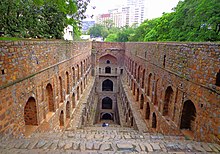Stepwell


A Stepwell ( English step well ; gujarati : vav ; Hindi : baoli ; locally also jhalra ) is a fountain , of the stages because of the construction having a different surface area, depending on the water level. Stepwells are among the most original and original contributions of the Indian subcontinent to world architecture. The Rani Ki Vav of Patan is since 2014 as a UNESCO - World Heritage Site recognized. The structural or linguistic demarcation from the Hindu temple ponds ( kunds ) is often fluid (e.g. Potra Kund in Mathura , Suraj Kund in Lucknow or Durga Kund in Varanasi ).
history
Step wells could already have been known at the time of the Indus cultures , because larger pools of water were uncovered during the excavations in Dholavira and Mohenjo-Daro - in Dholavira even with stairs. Otherwise, the oldest evidence is small, carved in the rock complexes from the 2nd to 4th century AD near Buddhist or Hindu rock monasteries. The first structural examples made of stone appear in the 7th century, but almost nothing has survived. Two of the oldest surviving examples are the Mata Bhavani Vav in Ahmedabad , Gujarat and the Chand Baori in Abhaneri , Rajasthan; both come from the 8th / 9th centuries Century, but have been repeatedly restored and renewed. Most of the surviving examples date from the 11th to 15th centuries and are located in or near larger cities.
background
Especially in the arid and poor or remote areas of north-west ( Gujarat , Rajasthan ) and south India ( Karnataka ) as well as south Pakistan ( Sindh ), where the annual monsoon only brings rain for a few weeks, it was necessary to use what was abundant for a short time To store water. This could be done in cisterns and wells , but the amounts of precipitation were often so enormous that even larger reservoirs could be filled, which was extremely important for the growing population, who now also settled and farmed in the hinterland of the rivers. This created either by rubble , later of dressed stone framed shallow pools or sunken into the ground stepwells that - be at the surface fenced or walled had to contamination of the water by animals or to avoid their carcasses - like all wells. At the deepest point where the well was in contact with the water table, but also on the steps, mud settled that had to be removed again and again - as well as fetching water, women were mostly responsible for this work.
meaning
Apart from their practical use, the water- and thus life-giving stepwells also experienced a quasi-religious veneration, which was underlined by the east-west orientation that sometimes occurs and by images of gods or small niche temples in their walls (e.g. Rani Ki Vav in Patan and Mithi Vav in Palanpur , both in Gujarat ). In some cases, stepwells were built in the immediate vicinity of large temples (e.g. in Modhera , Gujarat); they are then more likely to be regarded as temple ponds (kunds) . During the period of Islamic dominance over large parts of the Indian subcontinent, however, the figural decorations of the originally Hindu stepwells were often destroyed; only a few examples have survived to this day. On the other hand, such wells were also built in Muslim times (e.g. the Agrasen Ki Baoli and the Gandhak Ki Baoli in Delhi or the Toor Ji Ka Jhalra in Jodhpur ).
architecture
There are essentially three types of stepwell - the simplest from a structural point of view is a flat square with steps ( ghats ) on the edges; Another is a deep, angular or round well shaft, the water of which can be reached via a one-sided staircase or ramp. The structurally most elaborate and visually impressive is a deep, square or rectangular pool surrounded on all or three sides by prism-shaped stairs and steps (e.g. Chand Baori in Abhaneri , Rajasthan).
What is striking is the fact that almost all well shafts are regularly designed to be round, but almost no round or oval step wells are known. An octagonal example is located at the Friday Mosque of Champaner .
photos
Adalaj stepwell near Gandhinagar , Gujarat
Chand Baori in the village of Abhaneri near Jaipur , Rajasthan
Dada Hari Ni Vav , Ahmedabad , Gujarat
Gandhak Ki Baoli , Delhi
Stepwell in Bonilla de la Sierra , Province of Avila , Spain
European stepwell
European step wells are very rare - the oldest is probably the well sanctuary of Santa Cristina , which belongs to the Sardinian nuragic culture and is located south of the town of Paulilatino ; a medieval or early modern stepwell with partially vaulted stairs is located in the former small town of Bonilla de la Sierra in the old Castilian province of Ávila , another example is in the Aragonese town of Calatorao . The latter can be assumed to have Arabic-Moorish origins or suggestions, although no such constructions are known in the southern and eastern Mediterranean.
literature
- Morna Livingston, Milo Beach: Steps to Water. The Ancient Stepwells of India. Princeton Architectural Press, 2002, ISBN 1-56898-324-7 .
- Jutta Jain Neubauer: The Stepwells of Gujarat. An Art-historical Perspective. Abhinav Publications, 1981, ISBN 0-39102-284-9 .
Web links
- Stepwell in North and Central India - Photos + Info (English)
- Step wells in Gujarat - Photos and information (English)
- Step wells in northern India - Photos and information (English)









